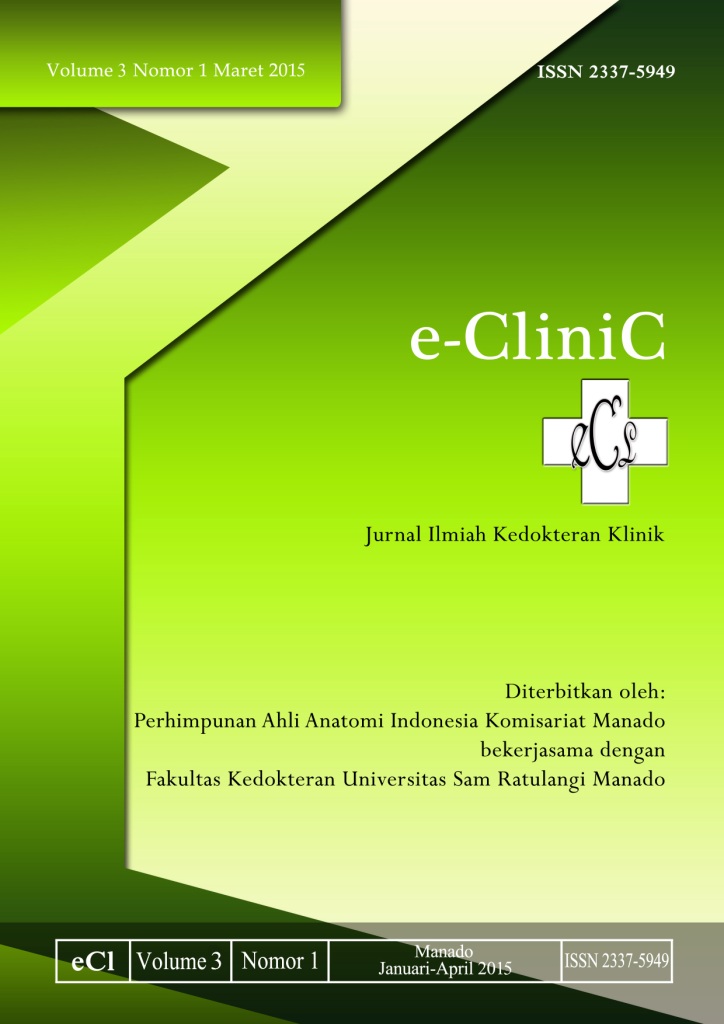PROFIL PITIRIASIS VERSIKOLOR DI POLIKLINIK KULIT DAN KELAMIN RSUP PROF. DR. R.D KANDOU MANADO PERIODE JANUARI – DESEMBER 2012
DOI:
https://doi.org/10.35790/ecl.v3i1.6761Abstract
Abstract: Pityriasis versicolor is a superficial fungal infection of the epidermal layer caused by Malassezia furfur or Pityrosporum orbiculare. This infection is chronic, mild, and usually without inflammation. Pityriasis versicolor infects the face, neck, torso, upper arms, underarms, thighs, andgroin. Skin disorders are very superficial and pityriasis versicolor is most commonly found in the body. The disorder is seen a spatches of colorful irregular shape to a regular, well defined to diffuse. The disorder is usually asymptomatic so that sometimes people do not know they have been infected. This study aims to determine profil of pityriasis versicolor at dermatovenereology clinic of Prof. Dr. R. D. Kandou General Hospital Manado periods January- December 2012. This retrospective descriptivestudy is based on the number of cases, gender, age, occupation, color of lesion, location of lesion, and the type of treatment. The results of this study showed that out of the 50 pityriasis versicolor cases (1.24%), male as the most infected gender (74%), along with the age group 25-44years (28%), the most job is civil servant (24%), and with hypopigmented lesions as the most types found (78%). The most frequent location of lesion is a combination of several places such as the face, body and extremities (60%), and the most used treatment is a combination therapy of oral and topical anti fungal (72%).
Keywords: pityriasis versicolor
Abstrak: Pitiriasis versikolor adalah infeksi jamur superfisial pada lapisan tanduk kulit yang disebabkan oleh Malassezia furfur atau Pityrosporum orbiculare. Infeksi ini bersifat menahun, ringan, dan biasanya tanpa peradangan. Pitiriasis versikolor mengenai muka, leher, badan, lengan atas, ketiak, paha, dan lipat paha. Kelainan kulit pitiriasis versikolor sangat superfisial dan ditemukan terutama di badan. Kelainan ini terlihat sebagai bercak-bercak berwarna-warni bentuk tidak teratur sampai teratur, batas jelas sampai difus. Kelainan biasanya asimptomatik sehingga adakalanya penderita tidak mengetahui bahwa ia berpenyakit tersebut. Tujuan penelitian ini adalah untuk mengetahui profil pitiriasis versikolor di Poliklinik Kulit dan Kelamin RSUP Prof. DR. R.D. Kandou Manado periode Januari-Desember 2012. Penelitian ini merupakan penelitian deskriptif retrospektif berdasarkan jumlah kasus, jenis kelamin, umur, pekerjaan, warna lesi, lokasi lesi, dan jenis pengobatan. Hasil penelitian ini menunjukkan bahwa dari 50 kasus pitiriasis versikolor ( 1,24% ) terbanyak adalah jenis kelamin laki-laki (74%), kelompok umur 25-44 tahun (28%), pekerjaan yang terbanyak adalah PNS (24%), jenis lesi paling banyak lesi hipopigmentasi (78%), lokasi lesi paling sering yaitu kombinasi yang terdapat dibeberapa tempat seperti wajah, badan dan ekstremitas ( 60%), dan pengobatan yang paling banyak adalah terapi kombinasi antijamur oral dan antijamur topikal (72%).
Kata kunci: pitiriasis versikolor
Downloads
Published
How to Cite
Issue
Section
License
COPYRIGHT
Authors who publish with this journal agree to the following terms:
Authors hold their copyright and grant this journal the privilege of first publication, with the work simultaneously licensed under a Creative Commons Attribution License that permits others to impart the work with an acknowledgment of the work's origin and initial publication by this journal.
Authors can enter into separate or additional contractual arrangements for the non-exclusive distribution of the journal's published version of the work (for example, post it to an institutional repository or publish it in a book), with an acknowledgment of its underlying publication in this journal.
Authors are permitted and encouraged to post their work online (for example, in institutional repositories or on their website) as it can lead to productive exchanges, as well as earlier and greater citation of the published work (See The Effect of Open Access).







